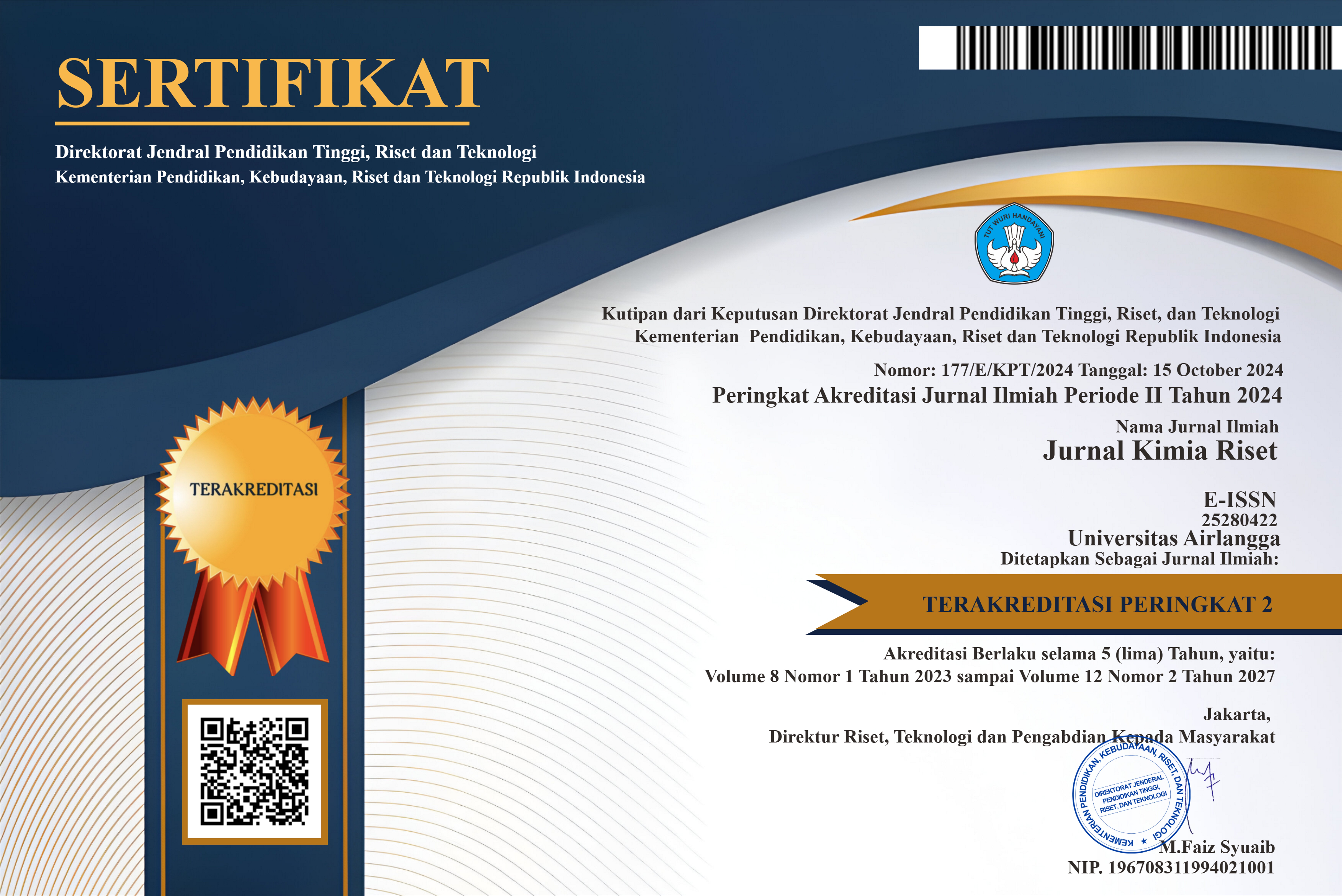DEGRADATION OF TETRACYCLINE BY FLOATING PHOTOCATALYST TiO2/Ni-COCONUT FIBER
Downloads
The photocatalyst process involves light (photons) as an energy source and catalysts such as TiO2 to accelerate the reaction. Efforts are made to reduce the band gap energy of TiO2 by shifting the absorption towards visible light using metal cation doping, such as Ni2+, and they can float on the surface with coconut fiber. XRD characteristics with TiO2 diffractogram experienced a 2θ shift as an indication that Ni has entered the TiO2 structure and seen some peaks decreased in intensity after being embedded with coconut fiber as an indication that TiO2/Ni has successfully attached to the fiber. The band gap energy on TiO2 is 3.21 eV with a wavelength of 386.5 nm in UV light. TiO2/Ni-coconut fiber experienced a shift in band gap energy to 3.09 eV with a wavelength of 400.9 nm, which is in visible light. This indicates that Ni has successfully entered the TiO2 structure. The TiO2/Ni catalyst embraced with coconut fiber has a higher degradation activity than the catalyst without an embrainer, with a percent degradation of 28.66% for 120 minutes of irradiation. This is influenced by the amount of light that can be absorbed during the photocatalysis process.
Abel, U.A., Habor, G.R. and Oseribho, O.I., 2020. Adsorption studies of oil spill clean-up using coconut coir activated carbon (CCAC). American Journal of Chemical Engineering, 8(2), 36–47.
Aritonang, A.B., Parwaty, P., Wibowo, M.A. and Ardiningsih, P., 2022. Sintesis TiO2-rGO dengan pereduksi alumunium untuk fotokatalisis degradasi metilen biru dibawah irradiasi sinar tampak. Equilibrium Journal of Chemical Engineering, 6(2), 150–156.
Brillas, E., 2023. Progress of antibiotics removal from synthetic and real waters and wastewaters by persulfate-based advanced oxidation processes. Journal of Environmental Chemical Engineering, 11(6), 1–38.
Chen, H., Zhang, Y.J., He, P.Y., Li, C.J. and Li, H., 2020. Coupling of self-supporting geopolymer membrane with intercepted Cr(III) for dye wastewater treatment by hybrid photocatalysis and membrane separation. Applied Surface Science, 515(13), 1–9.
Deswardani, F., Muhammad, D. and Manda, P.D., 2022. Karakterisasi TiO2/karbon aktif dari ampas kopi dan uji adsorpsinya terhadap limbah tetrasiklin (C22H24N2O8). Journal Online of Physics, 8(1), 16–21.
Fan, B., Tan, Y., Wang, J., Zhang, B., Peng, Y., Yuan, C., Guan, C., Gao, X. and Cui, S., 2021. Application of magnetic composites in removal of tetracycline through adsorption and advanced oxidation processes (AOPs): a review. Processes, 9(1644), 1–24.
Fitri, W. and Mora, 2018. Pengaruh persentase serbuk ampas tebu terhadap sifat fisik dan mekanik papan semen partikel. Jurnal Fisika Unand, 7(4), 367–373.
Heberer, T. and Feldmann, D., 2008. Removal of pharmaceutical residues from contaminated raw water sources by membrane filtration. Pharmaceuticals in the Environment, 427–453.
Illahi, A.N., Rouf, U.A., Maulidianingtyas, H., Hastuti, E., Prasetyo, A. and Istighfarini, V.N., 2020. Sintesis dan karakterisasi material fotokatalis heterojunction Bi4Ti3O12/SrTiO3 dengan metode sonikasi. Jurnal Kimia Riset, 5(1), 36–43.
Jafari, A.J., Kakavandi, B., Jaafarzadeh, N., Kalantary, R.R., Ahmadi, M. and Babaei, A.A., 2017. Fenton-like catalytic oxidation of tetracycline by AC@Fe3O4 as a heterogeneous persulfate activator: adsorption and degradation studies. Journal of Industrial and Engineering Chemistry, 45, 323–333.
Kanani, N., Saputro, A.B.A., Puspawati, I. and Pratama, A.A., 2019. Preparasi selulosa dari limbah tongkol jagung dengan bantuan gelombang iradiasi ultrasonik. Inudstrial Research Workshop and National Seminar. 20–27.
Kusuma, H.S., Aigbe, U.O., Ukhurebor, K.E., Onyancha, R.B., Okundaye, B., Simbi, I., Ama, O.M., Darmokoesoesmo, H., Widyaningrum, B.A., Osibote, O.A. and Balogun, V.A.B., 2023. Biosorption of methylene blue using clove leaves waste modified with sodium hydroxide. Results in Chemistry, 5(100778), 1–15.
Li, W.Y., Wang, Q., Xiao, Q.F. and Dong, B.Z., 2009. Removal of tetracycline and oxytetracycline in water by a reverse osmosis membrane. International Conference on Bioinformatics and Biomedical Engineering. 1–4.
Linsebigler, A.L., Lu, G. and Yates, J.T., 1995. Photocatalysis on TiO2 surfaces: principles, mechanisms, and selected results. Chemical Reviews, 95(3), 735–758.
Lismeri, L., Zari, P.M., Novarani, T. and Darni, Y., 2016. Sintesis selulosa asetat dari limbah batang ubi kayu. Jurnal Rekayasa Kimia dan Lingkungan, 11(2), 82–91.
Liu, D., Li, C., Zhao, C., Nie, E., Wang, J., Zhou, J. and Zhao, Q., 2022. Efficient dye contaminant elimination and simultaneously electricity production via a Bi-doped TiO2 photocatalytic fuel cell. Nanomaterials, 12(210), 1–12.
Ma, X., Chen, K., Niu, B., Li, Y., Wang, L., Huang, J. and She, H., 2020. Preparation of BiOCl0.9I0.1/β-Bi2O3 composite for degradation of tetracycline hydrochloride under simulated sunlight. Chineese Journal of Catalysis, 41(10), 1535–1543.
Ma, Z., Ren, F., Yang, Z. and Volinsky, A.A., 2021. Theoretical and experimental studies on electronic structure and optical properties of Bi-doped anatase TiO2. Optik, 241(167107), 1–8.
Manoharan, R.K., Ishaque, F. and Ahn, Y.H., 2022. Fate of antibiotic resistant genes in wastewater environments and treatment strategies - a review. Chemosphere, 298(134671).
MiarAlipour, S., Friedmann, D., Scott, J. and Amal, R., 2018. TiO2/porous adsorbents: recent advances and novel Applications. Journal of Hazardous Materials, 341, 404–423.
Mohammadi, Z., Sharifnia, S. and Shavisi, Y., 2016. Photocatalytic degradation of aqueous ammonia by using TiO2-ZnO/LECA hybrid photocatalyst. Materials Chemistry and Physics, 184, 110–117.
Morin, J.V. and Santi, D., 2021. Pembuatan sistem vakum otomatis gas H2S berbahan TiO2-Ni/Al2O3 terkoneksi arduino uno pada laboratorium kimia. Jurnal Natural, 17(1), 1–17.
Nguyen, P.M., Afzal, M., Ullah, I., Shahid, N. and Baqar, M., 2019. Removal of pharmaceuticals and personal care products using constructed wetlands: effective plant-bacteria synergism may enhance degradation efficiency. Environmental Science and Pollution Research, 26, 21109–21126.
Ouyang, J., Zhou, L., Liu, Z., Heng, J.Y.Y. and Chen, W., 2020. Biomass-derived activated carbons for the removal of pharmaceutical mircopollutants from wastewater: a review. Separation and Purification Technology, 253(117536), 1–17.
Paredes, L., Murgolo, S., Dzinun, H., Othman, M.H.D., Ismail, A.F., Carballa, M. and Mascolo, G., 2019. Application of immobilized TiO2 on PVDF dual layer hollow fibre membrane to improve the photocatalytic removal of pharmaceuticals in different water matrices. Applied Catalysis B: Environmental, 240, 9–18.
Phromma, S., Wutikhun, T., Kasamechonchung, P., Eksangsri, T. and Sapcharoenkun, C., 2020. Effect of calcination temperature on photocatalytic activity of synthesized TiO2 nanoparticles via wet ball milling sol-gel method. Applied Sciences, 10(993), 1–13.
Pratiwi, E., Harlia and Aritonang, A.B., 2020. Sintesis TiO2 terdoping Fe3+ untuk degradasi rhodamin B secara fotokatalisis dengan bantuan sinar tampak. POSITRON, 10(1), 57–63.
Priatmoko, S. and Prambasto, S.B.., 2022. Komparasi aktivitas fotokatalitik Ni/TiO2 dan Zn/TiO2 untuk dekomposisi air menjadi H2. Indonesian Journal of Mathematics and Natural Sciences, 45(1), 38–44.
Rachmawati, D.O. and Gunadi, I.G.A., 2020. Development of natural fiber composites based on thickness swelling using palm fiber and coconut fiber paper. International Conference on Innovative Research Across Disciplines (ICIRAD). 294–299.
Rachminisari, A., Salim, A., Nana, A. and Dimyati, A., 2020. Synthesis and characterization of photocatalist TiO2 doped with Ni for treatment of waste model from nuclear facility. Journal of Physics: Conference Series, 1436(012096), 1–9.
Rahmawati, A. and Kusumawati, D.H., 2020. Review: komposit TiO2/rGO sebagai fotokatalis untuk mendegradasi zat warna. Jurnal Inovasi Fisika Indonesia, 9(2), 78–84.
Rosanti, A.D., Wardani, A.R.K. and Latifah, E.U., 2020. Pengaruh variasi konsentrasi urea terhadap fotoaktivitas material fotokatalis N/TiO2 untuk penjernihan limbah batik tenun ikat kediri. Jurnal Kimia Riset, 5(1), 55–66.
Saputri, L.H. and Sukmawan, R., 2020. Pengaruh proses blending dan ultrasonikasi terhadap struktur morfologi ekstrak serat limbah batang kelapa sawit untuk bahan baku bioplastik (selulosa asetat). Rekayasa, 13(1), 15–21.
Sawunyama, L., Oyewo, O.A., Seheri, N., Onjefu, S.A. and Onwudiwe, D.C., 2023. Metal oxide functionalized ceramic membranes for the removal of pharmaceuticals in wastewater. Surfaces and Interfaces, 38(102787).
Sboui, M., Nsib, M.F., Rayes, A., Ochiai, T. and Houas, A., 2017. Application of solar light for photocatalytic degradation of Congo red by a floating salicylic acid-modified TiO2/palm trunk photocatalyst. Comptes Rendus Chimie, 20(2), 181–189.
Sboui, M., Nsib, M.F., Rayes, A., Swaminathan, M. and Houas, A., 2017. TiO2–PANI/cork composite: a new floating photocatalyst for the treatment of organic pollutants under sunlight irradiation. Journal of Environmental Sciences, 60, 3–13.
Serna-Galvis, E.A., Berrio-Perlaza, K.E. and Torres-Palma, R.A., 2017. Electrochemical treatment of penicillin, cephalosporin, and fluoroquinolone antibiotics via active chlorine: evaluation of antimicrobial activity, toxicity, matrix, and their correlation with the degradation pathways. Environmental Science and Pollution Research, 24, 23771–23782.
Setiawan, A., Sugiarto, C., Mayangsari, N.E., Ari, M. and Santiasih, I., 2023. Sintesis dan karakterisasi komposit TiO2/zeolit sebagai fotokatalis pada degradasi amonia di dalam air limbah. Jurnal Teknologi, 15(1), 87–96.
Su, Y., Wang, X., Dong, S., Fu, S., Zhou, D. and Rittmann, B.E., 2020. Towards a simultaneous combination of ozonation and biodegradation for enhancing tetracycline decomposition and toxicity elimination. Bioresource Technology, 304(123009), 1–6.
Sugandi, D., Agustiawan, D., Wijayanto, E., Vebriyanti, L.M.L., Panaya, G.Y.L. and Wahyuni, N., 2023. Sunlight assisted degradation of linear alkylbenzene sulfonate by floating catalyst TiO2-coconut fiber. POSITRON, 13(1), 69–76.
Tang, J. and Wang, J., 2018. Metal organic framework with coordinatively unsaturated sites as efficient Fenton-like catalyst for enhanced degradation of sulfamethazine. Environmental Science and Technology, 52(9), 5367–5377.
Wang, L., Jin, P., Duan, S., She, H., Huang, J. and Wang, Q., 2019. In-situ incorporation of Copper(II) porphyrin functionalized zirconium MOF and TiO2 for efficient photocatalytic CO2 reduction. Science Bulletin, 64(13), 926–933.
Wang, Xin, Wang, W., Wang, Xuejiang, Zhao, J., Zhang, J. and Song, J., 2016. Insight into visible light-driven photocatalytic degradation of diesel oil by doped TiO2-PS floating composites. Environmental Science and Pollution Research, 23(18), 18145–18153.
Wardani, G.A., Octavia, A.N., Fathurohman, M., Hidayat, T. and Nofiyanti, E., 2022. Arang aktif ampas tebu termodifikasi kitosan sebagai adsorben tetrasiklin: pemanfaatan metode kolom. KOVALEN: Jurnal Riset Kimis, 8(3), 280–291.
Xing, Z., Zhang, J., Cui, J., Yin, J., Zhao, T., Kuang, J., Xiu, Z., Wan, N. and Zhou, W., 2018. Recent advances in floating TiO2-based photocatalysts for environmental application. Applied Catalysis B: Environmental, 225, 452–467.
Yuan, F., Hu, C., Hu, X., Wei, D., Chen, Y. and Qu, J., 2011. Photodegradation and toxicity changes of antibiotics in UV and UV/H2O2 process. Journal of Hazardous Materials, 185(2–3), 1256–1263.
Zarrin, S. and Heshmatpour, F., 2018. Photocatalytic activity of TiO2/Nb2O5/PANI and TiO2/Nb2O5/RGO as new nanocomposites for degradation of organic pollutants. Journal of Hazardous Materials, 351, 147–159.
Zhang, J., Zhou, P., Liu, J. and Yu, J., 2014. New understanding of the difference of photocatalytic activity among anatase, rutile and brookite TiO2. Physical Chemistry Chemical Physics, 16, 20382–20386.
Zulkifli, Dharmawan, I.B. and Anhar, W., 2020. Analisa pengaruh perlakuan kimia pada serat terhadap kekuatan impak charpy komposit serat sabut kelapa bermatriks epoxy. Jurnal Polimesin, 18(1), 47–52.
Copyright (c) 2023 Jurnal Kimia Riset

This work is licensed under a Creative Commons Attribution-NonCommercial-ShareAlike 4.0 International License.
COPYRIGHT NOTICE
1. By submitting the article to Jurnal Kimia Riset (JKR), the author has agreed to transfer some of the copyrights to the publisher of the research chemistry journal, Universitas Airlangga, indicated in the Copyright Transfer Agreement.
2. Authors still retain significant rights to use and share their own published articles for non-commercial purposes subject to Creative Commons Attribution-NonComercial 4.0 International License
3. All publications (printed/electronic) are open access for educational purposes, research, library, and other non-commercial purposes. Besides the purposes mentioned above, the editorial board is not responsible for copyright violations.














